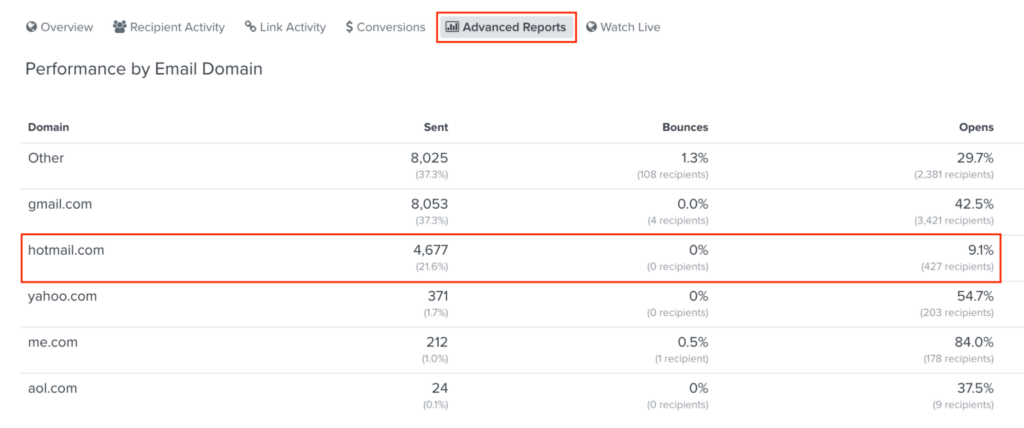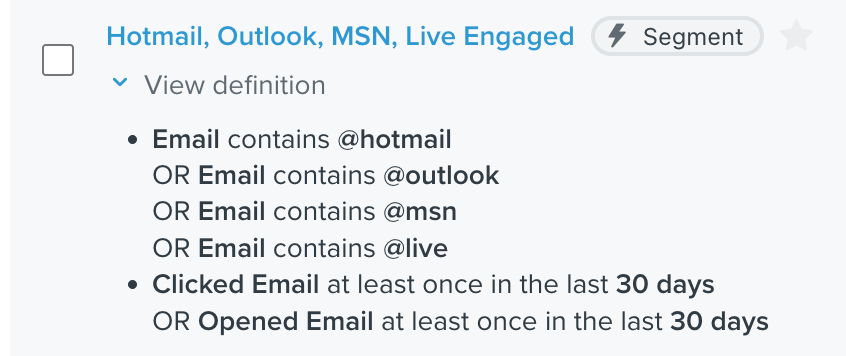If you’re an email marketer or a brand that engages in email marketing, it’s likely you’ve experienced from time to time, difficulties delivering emails to Microsoft-owned mailboxes, such as Hotmail, Outlook.com, Live and MSN.
Combined, Microsoft mailboxes make up approximately 5% of the world’s email accounts. However, for eCommerce brands, this percentage increases significantly and can often make up anywhere between 15-20% of your overall mailing list.
So when your email campaigns experience a drop in open rates and overall engagement to inboxes such as Hotmail, key engagement metrics such as site activity or sales conversions can be heavily impacted.
How to determine if you have a Hotmail deliverability issue
When you send an email campaign, your platform’s post-delivery reporting will often report an overall open rate.
However, this is often reported as an average open rate across all mailbox domains – which can mask any potential underlying deliverability issues you might be experiencing with particular mailbox domains.
For Klaviyo users, this can easily be identified by accessing the Advanced Reports tab when reviewing your campaign’s results.

As you can see in this example, despite healthy engagement across the board, delivery to Hotmail.com is far below the other mailbox domains. In fact, in this example, the overall open rate was around 31%, which easily masks the issues exhibited by Hotmail and could easily go unnoticed for an extended period of time.
What is email deliverability?
Email deliverability is a complex topic that requires a lengthy explanation to properly cover the subject. However, the core of email deliverability is the ability to deliver email successfully to a recipient’s inbox.
Delivering an email isn’t as simple as hitting the send button. With the amount of spam and inbox clutter being sent on a daily basis, mailboxes like Microsoft will implement measures to protect their user’s inboxes from malicious or unwanted emails.
There are a wide variety of ways these measures are put into place, but the important thing to understand is that different mailbox domains implement different methods and levels of inbox filtration.
Poor deliverability is typically a result of poor sender reputation (another complex email topic), and a poor sender reputation usually means a history of bad email practices.
But what about our example above? Surely they weren’t practitioners of bad emailing behaviour?
Hotmail and Microsoft mailbox algorithms
In order to combat the prevalence of spam and inbox clutter, mailbox domains such as Microsoft will routinely adjust their spam filter algorithms to protect their users’ inboxes.
However, since February 2022 there has been a significant increase in emails being caught in Microsoft’s spam filters, causing heartache for brands that traditionally had reasonable levels of engagement with audiences on Hotmail, Outlook.com, Live and MSN.
So what happened?
Microsoft has developed their own proprietary spam filter system called “Exchange Online Protection” and “SmartScreen”.
Together, they use a combination of sending IP addresses, sender domains, database quality, content and subscriber engagement as metrics to gauge against.
- Exchange Online Protection focuses on IP and domain reputation, authentication and spammer infrastructure, and less on content filtering.
- The SmartScreen filter is influenced by many factors related to the sender, including the sending IP address, domain, database quality, content and user engagement.
None of this is particularly new or different from the way many other spam filters determine what is inbox worthy or what is considered spam, however, the weighting and evaluation of each metric are what’s setting mailboxes like Hotmail and Outlook.com apart from the others.
Spam filters have traditionally been used to prevent malicious emails from reaching people’s inboxes, but recently we’ve also seen filters junking emails from legitimate brands at an increasing rate.
As we mentioned above, since February 2022, there has been a noticeable increase in legitimate brands finding their email marketing campaigns reaching the junk folder of Microsoft mailbox audiences. For retail and eCommerce brands, this is particularly impactful because mailboxes such as Hotmail and Outlook.com make up a significant portion of their mailing lists.
This has raised questions as to what’s going on. For plenty of brands, nothing about their sending behaviour has changed – so why the sudden drop in engagement?
Unfortunately, there is no clear-cut answer available other than Microsoft has changed its spam filter algorithm. How they have changed it and exactly what email marketers need to do won’t be revealed to the general public. Revealing the exact algorithmic requirements will just allow actual spammers to adapt and go back to infiltrating people’s inboxes.
This puts legitimate senders in a bit of a predicament. If email marketers don’t know what they should be doing, how are they meant to fix things?
How to fix inbox deliverability issues with Hotmail, Outlook.com and other Microsoft mailboxes
Although there are no clear-cut answers on how to correct email deliverability issues with Microsoft-owned mailboxes, there are things that all email marketers should be implementing to improve their chances of inbox throughput.
Aim for positive user engagement
Mailbox services such as Microsoft are placing an increasing emphasis on user engagement as a metric to determine whether an email is inbox worthy.
Positive email metrics include:
- Email opens
- Email clicks
- Adding your email address to a contact’s list
- Marking your email as important
On the other hand, negative email metrics include:
- Bounced email addresses
- Marking your email as spam
- Extended periods of inactivity (e.g. not opening emails)
As an email marketer, you will want to maximise those positive metrics and minimise the negative ones.
For Klaviyo users, this can be achieved by creating active audience “segments”. Rather than sending to your whole database, ideally, you should be targeting those that are engaged and active.
Here is an example of an engaged Microsoft mailbox group that you should be using:

Alternatively, you can go even more aggressive and activate Klaviyo’s Apple Privacy Opens metric:

When you’re using an email service provider (ESP), such as Klaviyo, as a feature you can send emails on behalf of your domain. It is as easy as entering your email address in the From Address field. But this also means anyone can do so as well.
So how do mailboxes like Hotmail/Outlook.com know if an email is actually coming from an authorised sender?
That’s where email authentication comes in.
There are a few types of widely recognised methods of email authentication, including:
- Sender Policy Framework (SPF)
- DomainKeys Identified Mail (DKIM)
- Domain-based Message Authentication Reporting and Conformance (DMARC)
In a nutshell, these methods of email authentication tell mailbox services like the ones that Microsoft operate that an ESP has authority to send on a brand’s behalf, using their domain address.
Many ESPs these days offer the ability to enable email authentication, in fact, it is highly recommended to do so!
For Klaviyo users, this can be achieved by going into your Account and choosing the Settings tab and then the Domain and Hosting tab and selecting Get Started. From there, you will need to follow a series of prompts. Note, in order to proceed with the setup of SPF and DKIM, you will need access to your domain registry portal.

Summary
As discussed, there isn’t a clear-cut method to fix email delivery issues to Microsoft-owned mailboxes such as Hotmail, Outlook, MSN and Live. However, all brands should be adhering to best practices, including engaging with active audiences and applying email authentication to improve the overall sender reputation.
If you’re currently experiencing issues sending to Hotmail mailboxes, for instance, it is important to start implementing these changes sooner, rather than later, as it becomes increasingly difficult to correct as time goes on.


